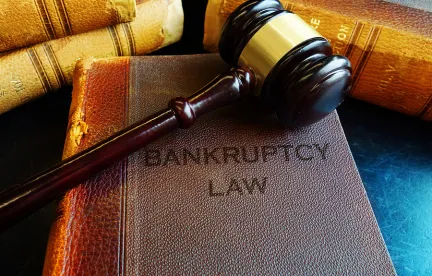A recent ruling in the Pacific Gas and Electric Company (PG&E) bankruptcy proceeding highlights the risk to certain renewable energy projects from utility bankruptcy. In a June 7, 2019 ruling, the PG&E bankruptcy court denied the claim that Federal Energy Regulatory Commission (FERC) must approve any attempt by bankruptcy courts to reject (i.e., void) power project agreements (PPAs) between renewable project owners and utilities. This is in direct opposition to a FERC ruling that it does have this power. The FERC ruling was made in January in response to a petition filed by PG&E’s suppliers. This FERC/bankruptcy court divide mirrors a deep split among federal courts on this issue.
The practical concern is that without FERC protection, bankruptcy courts will allow a financially imperiled utility to cut the contractual cord with its renewable energy providers – leaving those providers with environmental credits, energy and capacity that must be sold at a loss. When this happens, project owners can file unsecured claims in bankruptcy. However, such claims may be worth only pennies on the dollar.
PG&E found itself in this position because investigators determined one of the utility company’s lines started the 2018 Camp Fire, which burned more than 153,000 acres in northern California, killing 85 people and destroying 18,000 structures. Facing a torrent of claims, PG&E filed for bankruptcy.
A threshold question in the bankruptcy is who has final jurisdiction to determine whether PG&E could reject any of its PPAs and leave renewable project owners to fight for compensation as unsecured creditors. The bankruptcy court ruled that it has the “sole authority” over PG&E’s ability to reject any of its PPAs, meaning renewable power providers would stand in line behind billions of dollars of mortgage- backed claims held by bondholders. They would compete with an estimated $16 billion in unsecured claims emerging from the 2018 Camp Fire.
California law required PG&E to provide 15 days’ notice of its intention to file bankruptcy. Multiple counterparties to PPAs with PG&E were understandably concerned that PG&E would attempt to reject the PPAs in bankruptcy. They initiated two administrative actions, asking FERC to rule that both the bankruptcy court and FERC had to approve any proposed rejection of a PPA. On January 25 and 28, 2019 FERC ruled that it had “concurrent jurisdiction” along with
the bankruptcy court to review PPAs, in effect giving FERC veto power over any attempted rejection. FERC asserted that its jurisdiction extended to the enforcement of PPAs via its authority over the sale of wholesale power, which FERC ruled was inherently implicated if a PPA is rejected.
In a May 1, 2019 order, FERC ruled that:
Because the Commission’s jurisdiction attaches to wholesale power contracts, we find that the Commission has authority to enforce such contracts and order purchasers to continue to perform under the contracts, unless the purchaser is able to establish that the contract seriously harms the public interest or the Mobile-Sierra presumption otherwise does not attach to the contract.
At the outset of the bankruptcy case, PG&E immediately filed an adversary proceeding seeking a ruling that the bankruptcy court had exclusive jurisdiction over the rejection of any PPA pursuant to Section 365 of the Bankruptcy Code.1 On June 7, 2019, the Bankruptcy Court issued a strongly worded opinion rejecting FERC’s logic. The court stated:
To this court, FERC’s decision was not only unauthorized, but has and continues to have the effect of undermining the function of the bankruptcy court in its role of ensuring that the goals and purposes of bankruptcy law and policy are properly served and properly executed. Despite FERC’s lip service to what it describes as “concurrent jurisdiction” to carry out differing and perhaps competing policies, the effect of its decision gut and renders meaningless the bankruptcy court’s responsibilities in this area of the law.
For this reason, FERC must be stopped and the division and balance of power and authority of the two branches of government restored. Accordingly, and for the reasons that follow, the court declares FERC’s decision announcing its concurrent jurisdiction unenforceable in bankruptcy and of no force and effect on the parties before it. If necessary in the future it will enjoin FERC from perpetuating its attempt to exercise power it wholly lacks.2
The court discussed multiple reasons for its conclusion. The court noted that “[t]his is a matter of first impression: Is an order issued by a Federal agency purporting to affect (arrogate) a decision by a bankruptcy court in a future bankruptcy case binding on that bankruptcy court or the parties before it?”3 Under the court’s analysis, if FERC’s views prevail FERC could effectively veto the court’s ability to permit a rejection of a PPA under the bankruptcy code’s business judgment test.
Utility PPAs have been foundational to the successful financing of renewable energy projects in recent decades. These PPAs typically are mandated by state renewable portfolio standards (RPSs) which require utilities to purchase renewable energy credits and other outputs as part of their overall energy portfolios. Prices are often locked in for a decade or more to make the projects financeable.
In recent years renewable projects have become more cost effective. And cheap natural gas has reduced the cost of generating power using traditional means. As a result, market prices have declined and renewable project outputs often cannot be sold at the prices they commanded when the initial PPAs were negotiated. In the PG&E case, a bankruptcy plan dumping hundreds of megawatts of renewable resources on the market could itself depress market prices.
Bankruptcy courts seek to maximize value for all creditors. In reorganizing a company, rejecting above market contracts is an accepted way to increase the value of the enterprise. FERC, by contrast, regulates and protects electric markets seeking to prevent instability and disruption. The statutory mandates of the two bodies are starkly different.
This decision will likely be appealed, so this will be an interesting issue to follow as it makes its way through the courts.
1 Adversary Proceeding No. 19-03003. June 7, 2019
2 Memorandum Opinion, page
3 Id. At 9




 />i
/>i

